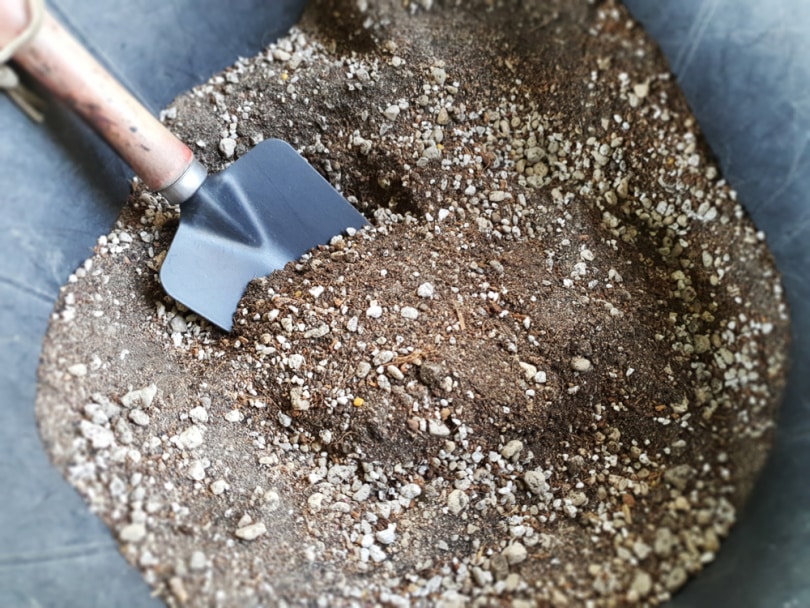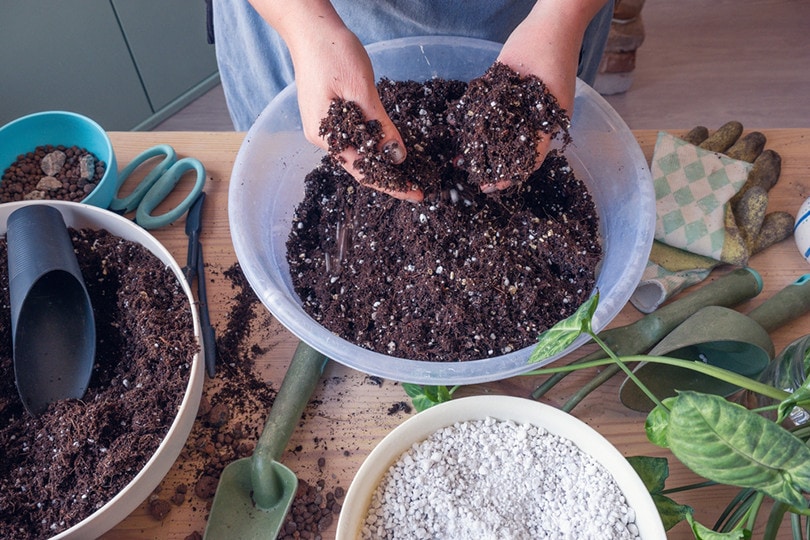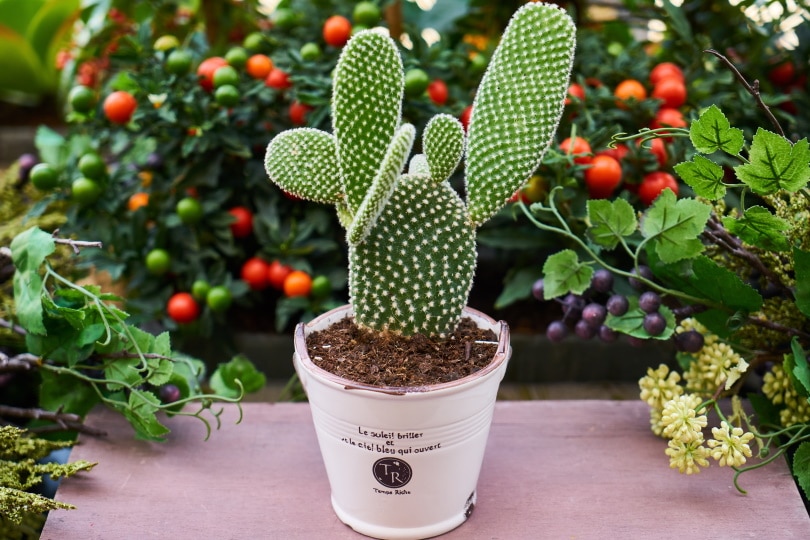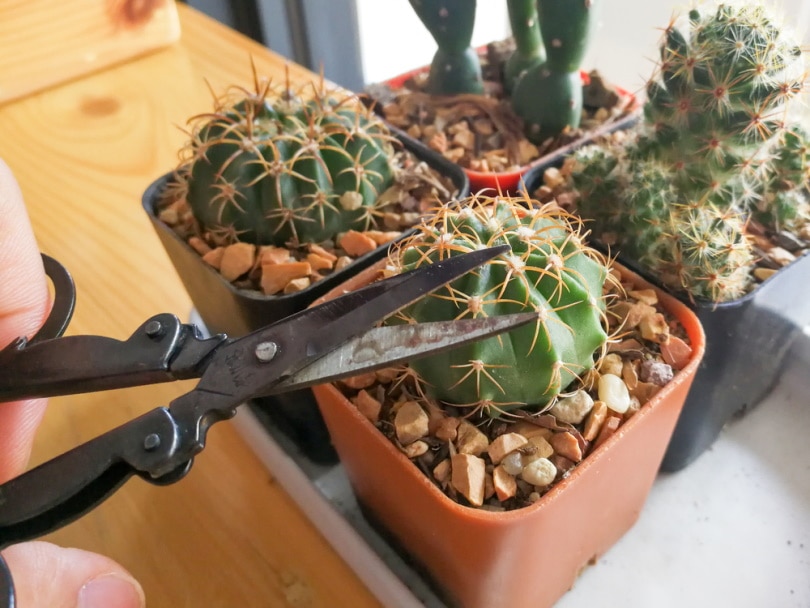What Is Cactus Soil: Differences, DIY, & FAQ
-
Pete Ortiz
- Last updated:

Cacti make excellent houseplants because they need minimal care. Under the right conditions, cultivating the plants and watching them thrive and blossom during spring or summer¹ can be gratifying. The most basic way to ensure your cacti grow healthy is to use the right potting mix.
So what is cactus soil?
Cactus soil differs from regular potting mixes because it contains organic and inorganic materials. Apart from regular gardening media, the soil also contains gravel, sand, and pumice, among other inorganic materials. These materials create a healthy environment for cacti to grow, keep the plant roots dry and aerated and reduce the risk of root rot or suffocation.
How Does Cactus Soil Differ from Regular Potting Mix?
A cactus is a succulent with a shallow root system, unlike most houseplants. Cactus soil is a unique kind of potting mix designed for succulents. It offers better drainage and aeration properties and is mainly composed of a rocky, mineral-rich media that mimics the natural environment where cacti grow in the wild.

Here’s a list of the main cactus soil versus potting mix differences:
Drainage & Moisture Retention
Cacti are forgiving because they don’t need watering on the same scale as regular houseplants. The plant quickly absorbs all the water it needs and stores it within its body. Using soil that will drain out excess water without turning overly dry or hard is crucial. The idea is to ensure the cacti roots don’t sit in moisture and rot.
The regular potting mix mainly contains organic materials that soak and retain moisture. On the other hand, cactus soil contains inorganic materials like sand or grit that cannot hold water. Fast-draining soil best mimics the native environment where cacti grow.
Composition
Regular potting mix differs from cacti soil in composition. While the former is rich in organic materials like coco coir, peat moss, compost, vermiculite, and pine bark, the latter consists of more significant portions of inorganic matter like gravel, sand, grit, pumice, and perlite.

Density
Succulents have a delicate root system, making them vulnerable to root damage if planted in compact soil. Compared to regular potting mix, cacti soil is less dense for enhanced airflow and root aeration. The inorganic materials in the soil help prevent soil compaction to ensure the plant thrives.
Nutrient Content
Regular gardening media often contains additional nutrients from fertilizers to enhance plant growth. Unfortunately, cacti thrive best in nutrient-deficient mediums and only need regular feeding during high-growth seasons (spring and summer). Using a potting mix with fertilizer can burn the roots or cause leggy growth.
 Steps for Making DIY Cactus Soil
Steps for Making DIY Cactus Soil
If you are a newbie in cacti parenting, your best option is to purchase cacti soil from a local garden center or nursery. A pre-made potting media designed for succulents contains everything your cacti need to thrive, including correct ratios of organic and inorganic materials. However, if you don’t mind getting your hands dirty, you can make your worn cacti soil. Follow the steps below.
1. Do Your Research
There are 2,000 to 3,000 cacti species with different environmental adaptations. Before preparing the soil, learn about your cactus species and where it grows natively. Note that tropical and desert cacti may have slightly different needs that dictate the ratios of various ingredients in their potting mix.
For instance, the holiday cactus is native to Brazilian tropical rainforests. Unlike desert cacti, the species receives plenty of rainwater all year round. While your cactus will still require a fast-draining medium, the soil composition should not dry out entirely. Hence, the potting mix should contain more organic than inorganic matter.

2. Gather Your Materials
Irrespective of the cactus species, you need organic matter and inorganic matter like pumice, crushed granite, chicken grit, sand, and perlite. Most importantly, prepare your planter and ensure it has drainage holes to let out excess water after watering.
3. Soil Preparation
During soil preparation, you should add one part of organic matter to two parts of inorganic matter. It is perfectly okay to choose the organic and inorganic materials based on your preference, provided the ratios remain the same. Just ensure you use quality and carefully selected ingredients to enhance the overall performance of your homemade cacti soil.
Your organic matter must not contain too much peat moss because it is dense and repels water. Materials like coco coir are less dense and hold just enough moisture to ensure the soil does not dry out too fast.
Also, if you opt to use gravel, ensure it’s about ¼ inch to avoid the risk of the material washing away through your planter’s drainage holes. It’s also a good idea to add perlite because it helps to enhance soil aeration.

4. Test the Finished Mix
The final step is to test your soil’s performance. Pour water into your mix and scoop some of the soil in your hand. Good cacti soil will remain reasonably sturdy when soaked. However, it will not form a sticky ball when you squeeze it. If the mix feels sturdy and can crumble a bit when soaking wet, it’s time to plant your cactus!
FAQs
Here are the answers to some frequently asked questions about cacti soil.
What Soil Do Cacti Need?
Cacti thrive in a semi-desert or desert-like environment. The right potting mix for your cacti should be sandy, pebbly, and porous to allow excellent drainage and aeration. Adding some organic material is crucial to ensure the soil holds the water for a good while to allow absorption before drying out.

Will My Cactus Thrive on Regular Potting Mix?
No. Regular potting mixes contain materials that retain moisture. Your cactus is a succulent species, and excess water can cause root suffocation, rot, or damage. The plant will have better chances of thriving in soil that contains both organic and inorganic matter like sand, perlite, grit, and pumice.
Can I Use My Leftover Cacti Soil for Other Houseplants?
If you have leftover cacti soil, you can use it to plant other succulents or a bonsai. The soil mimics the desert environment, making it unsuitable for leafy houseplants that require moisture-retaining soil. Moreover, it may not contain the nutrient content regular plants need to thrive.
Final Thoughts
Cacti are succulents with a shallow root system. The plants are also drought-tolerant, making them susceptible to root rot and damage when planted in soil with excess moisture. Cactus soil has a unique formulation containing inorganic materials. The soil’s composition allows proper drainage and root aeration to ensure your cacti thrive indoors.
Because of the hardy nature of cacti, repotting efforts can be futile, especially once the plant begins showing signs of retrogressing health.
To give your cacti the best survival chances, ensure you get your planting mix right. Before buying or making your potting media, learn about your cactus species and where it grows natively to make sure that you best meet its needs.
Featured Image Credit: THIPPTY, Shiutterstock
Contents


